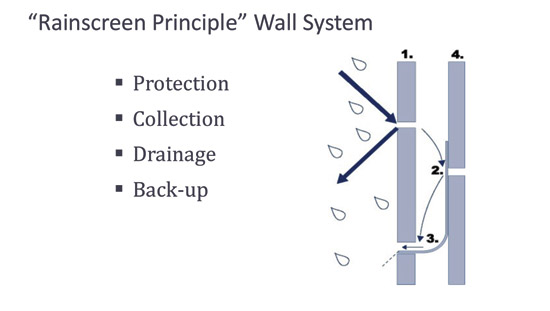Quality Masonry
CMU Specifications
CMUs must meet several specifications. In addition to ASTM E-119 Fire Safety and ASTM E-514 Water Penetration, ASTM C-90 is a standard specification that covers hollow and solid concrete masonry units made from hydraulic cement, water, and mineral aggregates with or without the inclusion of other materials. Parameters that must be met according to the standard include:
- Tolerance +/- 1/8 inch
- Shrinkage (0.065 percent)
- Minimum thickness of face shell and web ¾ to 1 ½ inches depending on width
- Water absorption rate based upon density
Density is a major factor in the specification. There are three classes of CMUs—normal weight, medium weight, and lightweight, with all three suitable for both loadbearing and nonloadbearing applications. Less than 105 pounds per cubic foot is considered light weight; less than 125 pounds per cubic foot, medium weight; and more than 125 pounds or greater per cubic foot, normal or heavy weight. Lightweight units are made from expanded shale or clay, and are best for fire rating and thermal performance, because of air voids in the units.
The ASTM C-90 Standard for compressive strength stipulates a minimum 1,900 psi (average of three), and no unit must fall below 1,700 psi.
Materials used in the unit affect the fire ratings, as does the size of the unit. As an example, an 8-inch x 8-inch x 16-inch hollow block would have a 2-hour rating at medium weight, a 2.75-hour rating at light weight and a 3-hour rating at an ultra light weight, which is a custom product. Architects can obtain a full list of hourly ratings from NCMA TEK 7.1 with the Equivalent Thickness Methodology, which nearly all specifications use or, alternatively, from laboratory test UL 618 or ASTM E119 which, however, is an expensive procedure.
While ASTM C-90 does set standards in several areas, it does not address thermal performance, sound transmission rating, or color and texture issues.
Addressing Moisture Issues
One of the most significant concerns in designing a wall is moisture. This section will explore the best way to design walls with moisture penetration in mind and with multiple lines of defense. The main objective is to keep water from penetrating or entering the wall in the first place. In addition to precipitation, moisture can enter masonry walls from several different sources, including capillary action, water vapor, and ground water. According to the National Concrete Masonry Association, successful moisture mitigation in concrete masonry walls involves a variety of techniques including flashing and counter flashing, weeps, vents, water repellents, sealants, post-applied surface treatments, vapor retarders, and crack control measures, with all components considered for redundant use yet with the appreciation that not all techniques will be suitable for all wall systems. The preferred approach to controlling moisture is to provide redundancy in a four-level line of defense including surface protection, internal protection, and drainage and drying, the idea being that water tightness of the wall will still be maintained even if one of these systems fails. This is referred to as the belt and suspenders approach.
 |
In a cavity wall we rely on gravity and an unobstructed 2-inch airspace to get water down to the flashing and the weeps. This is the basic rainscreen principle wall. |
Cost
In a cavity wall, designers rely on gravity and an unobstructed 2-inch airspace to get water down to the flashing and the weeps. This is the basic “rainscreen principle” wall. In a cavity wall are veneer, cavity, flashing and weeps, and backup. In Chicago, the cost to construct such a system is in the $30-per-square-foot range, based on the Masonry Advisory Council Cost Guide. Applying the rainscreen principle lines of defense to a single wythe wall, the components are an integral water repellent, drainable cores, flashing and weeps, an interior face shell, and post-applied water repellent. Again, according to the Masonry Advisory Council Cost Guide, the cost to construct such a system in Chicago is in the $12.50-per-square-foot range, some 58 percent less than the cavity wall.









